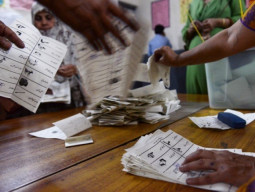
While the Pakistan Muslim League-Nawaz (PML-N) rejoices in retaining its seat in Chakwal, a report on accessibility to polling stations should attract the attention of the winning candidate if he wants a better turnout in the general elections later this year.
An accessibility audit report for polling stations in PP-20 Chakwal-I, issued by the Pakistan Alliance for Inclusive Elections (PAIE), found that only 16 per cent of polling stations met the accessibility criteria, set as per internationally essential accessibility criterions.
The criterions consider whether the surface of the pathways is obstacle free, levelled access to the entrance, wide pathways and corridors, availability of ramps in polling stations, availability of light in polling stations and presence of protruding objects among others.
The audit report notes that 84 per cent of the sampled polling stations in the constituency did not meet the essential accessibility criteria and hence differently abled people, elderly and sick were not able to make it to most of the polling stations.
Most of the polling stations, around 43 per cent of those sampled, did not have a firm and obstacle-free passage leading to the station. A further 39 per cent of buildings did not provide level access to the main entrance of the polling station.
Moreover, 79 per cent of polling stations not having level access also did not possess a ramp to facilitate those confined to wheelchairs.
In 66 per cent of cases, protruding objects were reported outside the polling stations, blocking the way.
While 82 per cent of polling stations had entrance gates which were sufficiently wide, but on election day, authorities had only opened the smaller gates citing security reasons.
“Those smaller gates possess multiple problems; firstly the lesser opening width than minimum standard of 32”, secondly the iron bar at lower edge of the metal gates that is always thicker than maximum door threshold standard of 6mm, thirdly the lower edge bar of the gates is generally two to three inches higher than ground causing another obstacle. In this scenario, if the ECP staff does not open larger gates for the differently-abled then all polling stations naturally become inaccessible for them,” the report noted.
The survey further revealed that the interior of the buildings and the outer entrance at 39 per cent of polling stations were not on the same level. Moreover, where there were ramps, only 21 per cent of these were of the required size.
There were few other facilities to ease the movement of the differently-abled.
“Even if the differently-abled and elderly cross the main gate of the building, 39% polling station buildings will still pose a challenge to them and they will have to cross stairs to reach the polling area.”
Most of the polling stations were well lit — lighting is one of the significant conditions of associability criteria — and 93 per cent of the polling stations had lighting arrangements on their gates.
This meant that only seven per cent of the sampled polling stations had unlit entrances.
The study further revealed that 79 per cent of inaccessible polling stations could be easily modified and made completely accessible. These modifications are minute such as the construction of small ramps at the entrance gate and the inner building, levelling of pathways in front of the polling stations, removing protruding objects from the pathway and the building, and by instructing the security staff to allow differently-abled to pass through the larger gate.
Published in The Express Tribune, January 11th, 2018.























































COMMENTS
Comments are moderated and generally will be posted if they are on-topic and not abusive.
For more information, please see our Comments FAQ